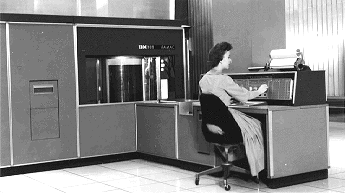RAMAC
RAMAC
(Random Access Method of Accounting and Control) The first hard disk computer, introduced by IBM in 1956. All 50 of its 24" platters together held a total of five million 8-bit alphanumeric characters (5MB). Weighing more than a ton, RAMAC was half computer, half tabulator, and more than a thousand units were built until production ceased in 1961. The RAMAC had a drum memory for program storage, but its I/O was wired by plugboard. The machine was a major breakthrough as all prior computer storage used magnetic tape.
RAMAC leased for $38,400 per year, equivalent to roughly $300,000 in 2020 dollars. About a third of the cost was RAMAC's "huge" disk system. However, 60 years later, that same amount of storage cost less than one thousandth of one cent on a multi-terabyte hard drive. See tabulator.
 |
| The RAMAC - One MP3 File |
|---|
| Although this was amazing technology in 1956, RAMAC's 50 platters in total held the equivalent of "one" MP3 music file. (Images courtesy of IBM.) |
 |
| The RAMAC - One MP3 File |
|---|
| Although this was amazing technology in 1956, RAMAC's 50 platters in total held the equivalent of "one" MP3 music file. (Images courtesy of IBM.) |
 |
| RAMAC Resurrected |
|---|
| In 1994, IBM reinstated the RAMAC name for its hard disk arrays. In 38 years, areal density vaulted from two thousand to 260 million bits per square inch, and access time decreased from 600 milliseconds to 9.5. (Image courtesy of IBM.) |
 |
| Would They Have Believed It? |
|---|
| A sale at Staples for 25,000 times as much storage cost 1/1000th of one month's rent of the RAMAC in 2020 dollars. |
Copyright © 1981-2025 by The Computer Language Company Inc. All Rights reserved. THIS DEFINITION IS FOR PERSONAL USE ONLY. All other reproduction is strictly prohibited without permission from the publisher.
Copyright © 2003-2025 Farlex, Inc
Disclaimer
All content on this website, including dictionary, thesaurus, literature, geography, and other reference data is for informational purposes only. This information should not be considered complete, up to date, and is not intended to be used in place of a visit, consultation, or advice of a legal, medical, or any other professional.